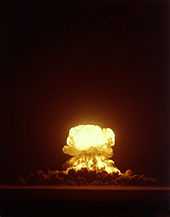Upshot-Knothole Harry
From Wikipedia, the free encyclopedia
| Upshot-Knothole Harry | |
|---|---|
 | |
| Information | |
| Country | United States |
| Test series | Operation Upshot-Knothole |
| Test site | Nevada Test Site |
| Date | May 19, 1953 |
| Test type | Atmospheric |
| Yield | 32 kt |
Upshot-Knothole Harry was a nuclear weapons test conducted by the United States as part of Operation Upshot-Knothole. It took place on May 19, 1953 in Yucca Flat, in the Nevada Test Site.[1]
The test device, codenamed Hamlet, was detonated atop a 300 foot tower.[2]
The Harry test released an unusually large amount of fallout (the highest of any test in the continental U.S.), much of which later accumulated in the vicinity of St. George, Utah. Because of this, the shot would become known as "Dirty Harry" in the press when details were released publicly. It would be among the most controversial of the U.S. nuclear weapon tests.
References
- ↑ U.S. Department of Energy / Nevada Operations Office, United States Nuclear Tests - July 1945 through September 1992, December 2000, DOE/NV-209 Rev 15
- ↑ "Operation Upshot-Knothole". The Nuclear Weapon Archive.
See also
This article is issued from Wikipedia. The text is available under the Creative Commons Attribution/Share Alike; additional terms may apply for the media files.